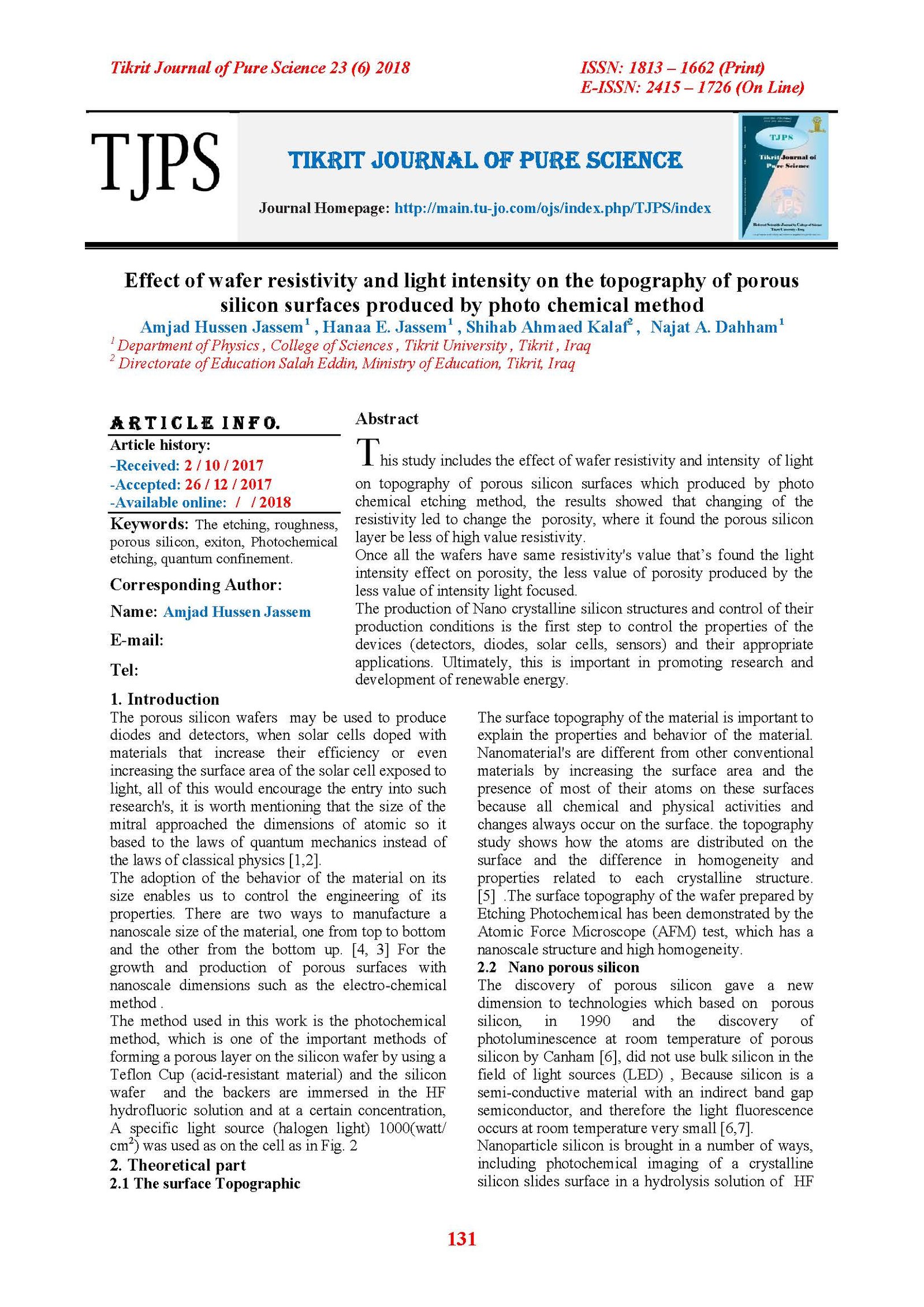Effect of wafer resistivity and light intensity on the topography of porous silicon surfaces produced by photo chemical method
Main Article Content
Abstract
This study includes the effect of wafer resistivity and intensity of light on topography of porous silicon surfaces which produced by photo chemical etching method, the results showed that changing of the resistivity led to change the porosity, where it found the porous silicon layer be less of high value resistivity.
Once all the wafers have same resistivity's value that’s found the light intensity effect on porosity, the less value of porosity produced by the less value of intensity light focused.
The production of Nano crystalline silicon structures and control of their production conditions is the first step to control the properties of the devices (detectors, diodes, solar cells, sensors) and their appropriate applications. Ultimately, this is important in promoting research and development of renewable energy.
Article Details

This work is licensed under a Creative Commons Attribution 4.0 International License.
Tikrit Journal of Pure Science is licensed under the Creative Commons Attribution 4.0 International License, which allows users to copy, create extracts, abstracts, and new works from the article, alter and revise the article, and make commercial use of the article (including reuse and/or resale of the article by commercial entities), provided the user gives appropriate credit (with a link to the formal publication through the relevant DOI), provides a link to the license, indicates if changes were made, and the licensor is not represented as endorsing the use made of the work. The authors hold the copyright for their published work on the Tikrit J. Pure Sci. website, while Tikrit J. Pure Sci. is responsible for appreciate citation of their work, which is released under CC-BY-4.0, enabling the unrestricted use, distribution, and reproduction of an article in any medium, provided that the original work is properly cited.
References
[1] Mohammad Saleh Al-Salhi, Abdullah Saleh Al-Dwayyan Introduction to Nanotechnology, collage of Science - Physics Department And Astronomy - King Saud University 2007.
[ 2 ] Mark Ratner, Dan Ratner, Nanotechnology Gentle Introduction, , Brown University (2002 .(
[3]Alaa Yousef Ali Mosleh, "Synthesis and Study of the Characteristics of a CdS Cytoskeletal Reagent in Thermal Chemical Spraying Method" (Master Thesis), collage of Education University of Tikrit (2011)
[ 4 ] Dr.Axel Zweck,Technological analysis, Future technologies division, Germany, (2004).
[ 5 ] S. Rengaraj, S. Hee, S. Venkataraj, Y. Kim, S. Vijayalakshmi, E. Repo, A. Koistinen, M. Sillanpaa. Dep. Chem. Phys. Univ. Eastern Finland, Patteristonkatu, Finland, J. Nanoscience. VoL.11 (2011).
[ 6 ] Canham L T Appl. Phys. VoL. 57, (1990(.
[ 7 ] C. Baratto, G. Faglia, G. Sberveglieri, Z.Gaburro, L. Pancheri, C. and L. Pavesi, Sensors2, (2002).
[ 8 ] Mischa Megens, Judith E. G.J. Lagendijk, and Willem L. Vos, Physical Review VoL 59 (1999(
[ 9 ] Gullis A G and Canham L T Nature, 353, (1991(.
[ 10 ] S. Ossicini, L. Pavesi, F. Priolo. 'Light Emitting silicon microphotonic'. Printed Germany (2003(
[ 11 ] Harrison P. Quantum well, wires and dots: Theoretical. J. Wiley & Sons Ltd.chisester (2000(
[ 12 ] Alessia Irrera, "Light emitting devices based on silicon nanostructures", Universita Degili Studidi Catania, Dottorato Diricerca in Scienza Materiali, (2003(
[ 13 ] A.M. Alwan, "Electrical properties of porous silicon prepared by photo chemical etching" Regional conference on solid state science and technology, (2005(.
